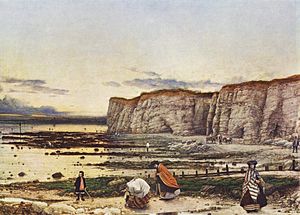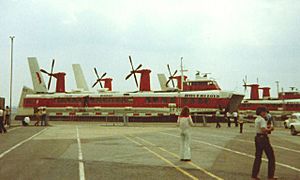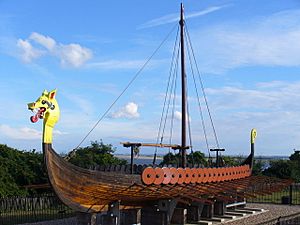Pegwell Bay facts for kids

Pegwell Bay is a wide, shallow bay on the English Channel coast in Kent, England. It's located between the towns of Ramsgate and Sandwich, where the River Stour meets the sea.
A big part of Pegwell Bay is a special nature reserve. Here, you can find different types of seashore areas like mudflats and salt marsh. These habitats are home to many waders (birds that wade in shallow water) and wildfowl (like ducks and geese) that stop here during their long migrations. You can visit this nature reserve through Pegwell Bay Country Park, which is easy to find off the A256 road that goes from Ramsgate to Dover.
Contents
What is the History of Pegwell Bay?
Roman Landings at Pegwell Bay
Experts who study old things, called archaeologists, believe that Pegwell Bay was the exact spot where the famous Roman leader Julius Caesar landed during his two invasions of Britain. This happened a very long time ago!
In 2017, archaeologists from the University of Leicester found the remains of a large Roman fort. This fort was built around 54 BC. Before this discovery, historians weren't sure exactly where Caesar's ships had landed. Finding the fort helped them figure it out.
Pegwell Bay in Art
The beauty of Pegwell Bay in 1858 was captured in a famous painting by William Dyce. The painting is called Pegwell Bay, Kent – a Recollection of October 5th 1858. You can see this artwork in the Tate Gallery in London.
Early Tourism and a Failed Pier
In the 1800s, people tried to make Pegwell Bay a popular seaside resort, just like nearby Ramsgate. They even built a pleasure pier, which is a long walkway going out into the sea. However, this idea didn't work out very well. The pier wasn't successful and was taken down before the end of the century.
What is the Hugin Longboat?
On the low cliffs above Pegwell Bay, right by the main road, you can see a full-size replica of a Scandinavian longboat. It even has shields along its sides! This boat is there to remember the first Anglo-Saxon people who landed in England around this area.
The replica boat is named Hugin. It sailed all the way from Denmark to Thanet in 1949. This journey celebrated 1,500 years since the traditional landing of the Anglo-Saxon leaders Hengist and Horsa. It also marked the story of Hengist's daughter, Rowena, marrying King Vortigern of Kent.
The Hugin was a gift to Ramsgate and Broadstairs from a newspaper called the Daily Mail. The goal was to keep the ship safe for many years. The Hugin was carefully repaired and restored between 2004 and 2005.
Other Important Historical Events
St Augustine's Landing
Close to Pegwell Bay, at a place called Ebbsfleet, is another important historical site. This is where St Augustine landed in 597 AD. He led the first Christian mission to southern England. A cross, known as St Augustine's Cross, marks this special event.
Pegwell Bay in Books
The bay is known for its tricky, soft areas of mud, called bogs, that appear at low tide. These bogs can be dangerous. They were even used as a key part of the story in Dennis Wheatley's 1938 thriller novel, Contraband. In the book, two of the main characters get into trouble in the bogs of Pegwell Bay.
The Old Hoverport

At the north-east end of Pegwell Bay, you can still see parts of what used to be Hoverlloyd's cross-channel hoverport. From 1969 to 1982, large hovercraft that carried both vehicles and passengers traveled from here across the English Channel to Calais, France.


